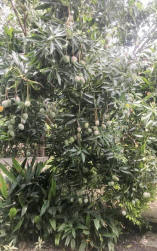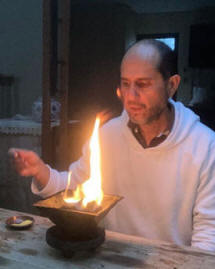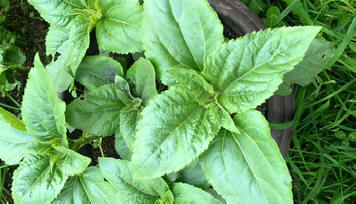Homa Gardening
While Homa farming has been found to yield excellent and sometimes amazing results, not everyone can have a Homa farm; a number of disciplines must be observed, and at least several people will be needed to meet the requirements. However, home gardeners have experienced wonderful results when Agnihotra and other Homa fires have been done in or near their gardens.–Ed.
 Oscar Ardila
Oscar Ardila
Sta. Martha, Magdalena
Colombia, South America
The harvest in the area goes between April and August-September. The second harvest begins at the end of the year and runs until February-March. This year the harvest in the surroundings here is not very productive; it is rather poor. It is scarce. However, our mango benefits from the fact that Agnihotra is done every day at sunrise and sunset. Also, Tryambakam Homa is being performed.
In addition, part of the Homa ashes are applied to the surrounding trees and ornamental plants. Our mango tree is so loaded with fruits that the branches reach the ground. The harvest is abundant and homogeneous and the flavor of the mangoes is exquisite. This variety is called sugar mango.

 I would like to share this technique, which I found:
I would like to share this technique, which I found:
If we place water near where we practice the Homa fires, that water is very healing. So, in addition to the Agnihotra ash, the water with which this ash is going to be consumed by people, plants or animals, accelerates the healing process. OM SHREE
 Fabian Toral
Fabian Toral
Cuenca, Ecuador, South America
I have been an Agnihotri for 12 years. I have been living in this house since a year and a half. I decided to build a mini garden. It is just about 3,5 x 3,5 meters, which are approximately10 square meters. I am doing the Homa fires regularly and there is always something to harvest in this little garden. I have seen incredible results.
For example, I have some swiss chard that gives me giant leaves with a delicious taste, and the plants continue to grow more and more leaves.
The zucchini plant I have produces so many fruits. Although the plant is almost dead, because it has completed its productive cycle, it continues to bear fruits in large quantities. That is because my plants are receiving all the energy of the Homa fires and also Agnihotra ash (whatever is left over after sieving it).
Practically within the city, at a height of 2500 meters, I cultivate a lot of things:
kale, 3 types of lettuce, chives, coriander, parsley, zucchini, swiss chard, beet, celery, dandelion (which grows wild), and also some medicinal and aromatic herbs such as mint, nettle, and other local herbs. I take some of the herbs from here to prepare plant-based cosmetics, which is my job.
I also have some flowers such as lavender, sunflowers, and a flower called ataco. The results are incredible. In such a small space, practicing the Homa fires, we can obtain results and feed ourselves from this.
I have a small composting area where I gather all the thicker branches of the plants and raw waste of vegetables and fruits from the kitchen, covering them with soil and adding Homa ash. It has no bad smell; it is clean and well cared for and that compost helps me to continue planting.
(It is recommended to spread Agnihotra ash on the soil when planting and transplanting. Ash from Om Tryambakam and Vyahruti Homa may be used on existing plants and spread on the lawn or over larger areas.-Ed.)






